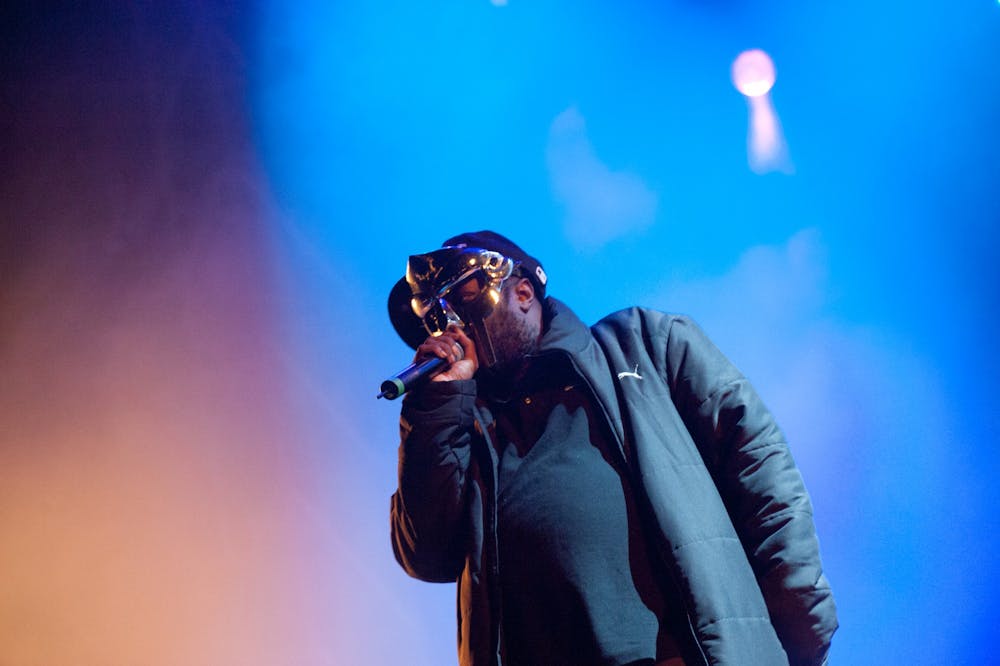No figure in hip-hop quite had MF DOOM’s mystique.
Amassing a cult following through his various aliases and albums, MF DOOM, born Daniel Dumile in 1971, became arguably the greatest underground hip-hop act of all time.
Using intricate wordplay and experimental instrumentals, Dumile had the rare ability to suspend the disbelief of listeners around the world.
Whether performing as Zev Love X of KMD, mad scientist Viktor Vaughn, space monster King Geedorah or metal-faced supervillain MF DOOM himself, the mystery surrounding the masked rapper transcended the stereotypes of contemporary hip-hop.
Each character had their own unique story, and even though they were all portrayed by the same artist, each had their own strengths, weaknesses and feelings toward the world they inhabited.
DOOM essentially created audio comics, and was able to bring listeners into his world. People could listen from their cars, homes or the beach; it didn’t matter. By juxtaposing real-life scenarios to the battles of a supervillain, DOOM was able to make talking to a girl at a bar seem like an intergalactic mission resulting in a heroic standoff.
His technique was flawless and his gruff voice highlighted the intensity of a supervillain who had realized the significance of his powers.
He is one of the greatest, if not the greatest, technical rappers of all time. His rhyme schemes were legendary and his innate ability to implement concepts into his music was unmatched. Look no further than 2004’s “Mm.. Food,” where DOOM essentially creates an album full of double entendres relating life to food.
But his music was only one side of him.
Like every villain, DOOM’s origin story is one of pain and betrayal.
At the beginning of his hip-hop odyssey, Dumile, formerly known as Zev Love X, was a member of the rap trio KMD, alongside brother DJ Subroc and fellow emcee Onyx. Fueled by a fierce sense of youth and rebellion, Dumile and KMD’s music expressed socially-conscious lyrics and messages with an anti-establishment undertone.
After KMD released its debut album “Mr. Hood” in 1991, the group was ready to release its sophomore effort “Black Bastards.”
Just before the release of “Black Bastards,” Subroc was struck by a car and killed while attempting to cross the Nassau Expressway. KMD was dropped from Elektra Records and in response to controversial cover art, “Black Bastards” was shelved the same week.
Following this series of traumatic events, Dumile abandoned the hip-hop world for three years and found himself bordering homelessness, sleeping wherever he could.
But like every great supervillain, Dumile encapsulated his trauma and turned it into a superpower. Zev Love X transformed into MF DOOM, a dastardly masked super villain with the lyrical power to eliminate any emcee in his path. Inspired by Marvel’s Dr. Doom, the character was a representation of a villain who used a brilliant sense of knowledge and ability to overtake the world of underground hip-hop.
Dumile’s return to hip-hop resulted in one of the most iconic characters in hip-hop history, and from 1997 to 2005, DOOM dominated the genre’s underground scene.
Dumile’s historic run of exceptional solo albums — “Operation: Doomsday,” “Take Me to Your Leader,” “Vaudeville Villain” and “Mm.. Food” — are considered underground hip-hop cult-classics. Collaborative efforts with Madlib (“Madvillainy”) and Danger Mouse (“The Mouse and the Mask”) were also met with critical and commercial success. “Madvillainy” is widely regarded as DOOM’s masterpiece and one of the greatest hip-hop albums of all time by critics and fans alike.
In a world where everybody knows everything about their favorite artists, the mysterious masked supervillain was a refreshing change from the status quo. DOOM’s mask brought a sense of ambiguity that made him special to everyone else. People felt that they knew everything about DOOM, while simultaneously knowing nothing at all. But that’s how he wanted it.
DOOM represented everything hip-hop should be, not only because he was a technically proficient, innovative rapper and producer, but also because his reason for donning the mask supports that claim.
In a rare 2011 interview with the Red Bull Music Academy, DOOM explained how the commercialization of hip-hop leads consumers to care more about how artists look than the quality of their music.
“Things from my point of view start going more toward what things look like opposed to what things sound like,” DOOM said. “Before, we didn’t know what emcee’s looked like until we went to the party and saw them rockin.”
The ultimate hip-hop purist, DOOM wanted his fans to appreciate his music for how it sounded, not what he looked like. By covering his face, he emphasized the importance of artistry and skill, not sex appeal or looks.
The character of DOOM wasn’t caught up in the fast life of rap fame. Instead, he was focused on being one of the genre’s great technicians.
“To him, he don’t care about the fame and none of that sh*t, that sh*t is [of] no consequence,” DOOM said. “It’s more of the message and what’s being said, so I think it (the mask) helps people focus more on what’s being said.”
Nothing shows how important DOOM was to hip-hop culture than the reactions of Tyler, the Creator and Earl Sweatshirt when the two met the elusive rapper for the first time. Both Tyler and Sweatshirt were in awe when they saw DOOM in person, showing that no matter how famous he was, DOOM’s mystique followed him everywhere he went.
These moments also showed how multi-faceted DOOM was. He not only worked with hip-hop’s OG’s but also inspired the youth of the culture. From collaborations with ’90s legends like Ghostface Killah to teenage stars like Bishop Nehru, DOOM always looked to advance the culture.
As a freshman in high school, I first discovered DOOM’s music hoping to become a more well-rounded hip-hop fan. I turned it on and honestly, I didn’t get it. I didn’t understand what he was saying or why he was saying it. I didn’t like how there were skits after almost every song and I didn’t understand the allure of the character.
DOOM’s music was the first to teach me that when listening to a great emcee, you have to sit with the music a little bit. You might not catch what he’s saying on the first or second listen, and you might not even catch it on your third or fourth try. But when it finally clicks, you’ll understand how brilliant the work is.
The more I listened, the more I understood the characters he was portraying.
Before I knew it, I had all of his albums saved to my library. Each album told a different story and took me into a world I never wanted to leave. DOOM suspended my disbelief with the stories he told and the skits that tied them together. Through supreme lyrical ability and storytelling skills over off-kilter boom-bap production, DOOM carved his own lane in hip-hop’s stratosphere.
The hip-hop world was shocked to hear about DOOM’s death on New Year’s Eve 2020, the final gut punch in what was a historically challenging year.
DOOM hadn’t shied away from his death in his music; like all supervillains, he knew his time would come eventually.
“Living off borrowed time, the clock tick faster / That’d be the hour they knock the slick blaster,” DOOM rapped on “Accordion.” DOOM knew he wouldn’t live forever, but the villain wouldn’t be killed by an enemy. He would go out on his terms, refusing to die by an enemy’s blaster.
Back in 1999, the masked villain discussed what his death would mean in his debut as DOOM in “Doomsday.”
“On Doomsday, ever since the womb / ‘Til I’m back where my brother went, that’s what my tomb will say / Right above my government; Dumile / Either unmarked or engraved, hey, who’s to say?”
The silver lining to DOOM’s death is that he’s finally reunited with his brother. Everything he did was in honor of his fallen soldier, and now the two are together once again.
Subroc might be slightly confused to see his brother wearing a metal mask, but he’s been watching DOOM from above all along.
Everything from DOOM’s career to his death was on brand. He held a mysterious aura about himself and never seemed to break character. Like the ultimate anti-hero, DOOM was a villain to the very end. His death was kept a secret for months, not only for the privacy of his family, but because that’s how a mysterious villain would go out. He wouldn’t want his enemies to know about his death, and he left as mysteriously as he entered.
His family said he “transitioned” on Oct. 31, 2020.
If DOOM’s mystique and death weren’t enough, it was only fitting he died on Halloween, the most haunted day of them all.
DOOM left a true villain, and we expected nothing less.
To keep his legacy alive, please remember his most famous request on 2004’s “All Caps.”
“Just remember ALL CAPS when you spell the man name.”
Thank you for nearly 30 years of innovation and excellence.
Safe travels, supervillain.
Anthony DeCicco is the senior sports editor and can be reached at anthony.decicco@ubspectrum.com

Anthony DeCicco is the Editor-in-Chief of The Spectrum. His words have appeared in outlets such as SLAM Magazine andSyracuse.com. In 2020, he was awarded First Prize for Sports Column Writing at the Society of Professional Journalists' Region 1 Mark of Excellence Awards. In his free time, he can be found watching ‘90s Knicks games and reading NFL Mock Drafts at 3 a.m.





